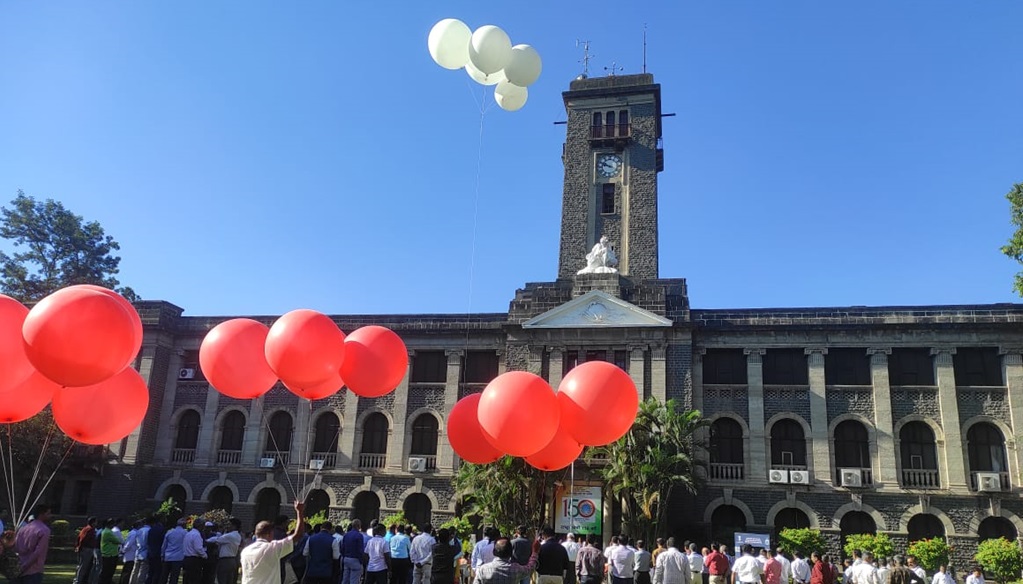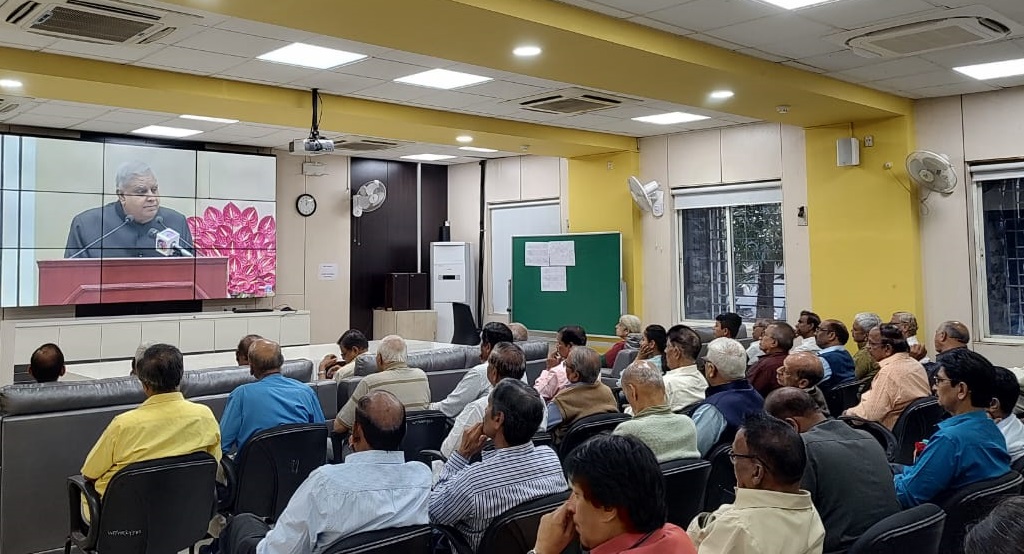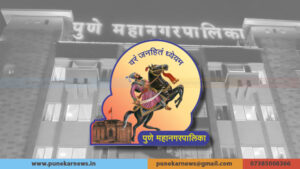Pune: India Meteorological Department (IMD) Marks 150 Years of Excellence

New Delhi/Pune, 15th January 2024: The India Meteorological Department (IMD), a cornerstone of weather forecasting in India, celebrated its 150th anniversary today. Citizens and retired officers had gathered at the IMD office (popularly called Shimla office) in Shivajinagar for the celebrations.
The distinguished event was graced by the Vice President of India, Jagdeep Dhankar, who served as the Chief Guest in the inaugural ceremony in New Delhi. Kiren Rijiju, Union Minister of Earth Sciences, honored the occasion as the Guest of Honour, while Dr. M Ravichandran, Secretary MoES, presided over the function. The ceremony witnessed the participation of former Secretaries of the Ministry of Earth Sciences, former Directors-General of IMD, Heads of various sister organizations in MoES, Secretaries of various Ministries, Chief Secretaries & Resident Commissioners of various States and Union Territories, Heads of various disaster management agencies, Heads of various Universities and institutions, employees of IMD, researchers & academicians, and members of the press & electronic media. An impressive 1,200 delegates from across the country actively participated in the event held in New Delhi.
Vice President Dhankar, in his address, lauded the IMD for its invaluable services to the nation and extended heartfelt congratulations on reaching this historic milestone. He acknowledged that the policies, plans, and programs of IMD align seamlessly with mainstream initiatives in India, reflecting the vision and mission of the Prime Minister and his team.
Dhankar recognized IMD’s pivotal role in increasing farmers’ income through accurate daily weather forecasts, hazard warnings, and crop weather advisories, in collaboration with the Ministry of Agriculture, state & central Agricultural Universities, and state Agricultural departments. The Vice President highlighted that a below-poverty-line (BPL) farmer with less than 2 acres of land in rainfed areas gains Rs 12,500 annually by utilizing weather information, contributing a significant Rs 13,300 crores to the GDP.

Emphasizing IMD’s support for Gati Shakti and Udaan Scheme, Dhankar commended the department for ensuring safe aviation through aviation weather monitoring and forecasting for all 117 airports. He applauded the indigenous development of various instruments and software to enhance weather and climate services, including the decision support system and the mobile app launched during the celebration. The Vice President expressed appreciation for IMD’s early warning services during Super Cyclone Amphan in 2020 and Cyclone MOCHA in 2023, earning accolades from the World Meteorological Organization (WMO), the United Nations, and the United Nations High Commissioner for Refugees (UNHCR). He commended IMD for its accurate forecast during Cyclone Biparjoy, which played a crucial role in achieving zero loss of life in Gujarat. Dhankar underlined IMD’s role in the economic development of the country across various sectors.
The release of ‘Mausam Gram’ aligns with the government’s program of “Sabka Saath Sabka Vikaas,” and Dhankar stressed IMD’s vital role in providing early warning to over 90% of the population. He highlighted the services rendered by IMD to the Power & Renewable Energy Sector, contributing to minimizing losses and improving the economy in line with the Government of India’s scheme “LIFE.” The National Framework of Climate Services, launched during the celebration, aims to maximize the utilization of climate information across all activities, with a special focus on disaster risk reduction, water, health, energy, and agriculture management.
Dhankar urged all stakeholders, including citizens, businesses, industries, farmers, fishermen, researchers, and academia, to utilize climate and weather information in their activities, fostering a “Weather Ready and Climate Smart India.”
Concluding his address, the Vice President emphasized that IMD must embrace new technologies to position India as a global leader in meteorological services. He acknowledged IMD’s international contributions, providing weather forecast services to countries in South Asia, Southeast Asia, the Middle East, and beyond, aligning with India’s ethos of Vasudhav Kutumbakam.
Union Minister Kiren Rijiju, speaking on the occasion, extended heartfelt congratulations to IMD on this momentous milestone. He applauded IMD’s proactive measures in enhancing the weather observational network in the country over the last decade. Rijiju highlighted significant advancements, such as the increase in Doppler radars from 15 in 2014 to 39 in 2023, additional 25 radars to be added in the next 2-3 years, and growth in rainfall monitoring stations, upper air stations, and high wind speed recorders. He informed the audience that the total number of radars in the country would reach 86 in the next 5 years, enabling the prediction of events like cloudbursts with sufficient lead time.
Rijiju expressed gratitude to the Prime Minister for the mega scheme PRITHVI, enabling the Ministry to undertake new initiatives for further improving services. He acknowledged IMD’s global leadership in scientific and technological innovations, expressing hope that it would continue to progress, innovate, and meet the needs of people worldwide.
Rijiju congratulated all IMD employees and the entire meteorological fraternity on achieving this significant milestone, envisioning IMD’s outreach to every household during this Amrit Kaal, providing scientific knowledge-based information and guidance for a resilient society and a partner in the 5 trillion dollar economy.
Dr. Mrutyunjay Mohapatra, Director General of Meteorology, IMD, in his Welcome Address, traced the evolution of meteorological services in the country from ancient times to the present day. He highlighted the paradigm shift in all components of the early warning system, including observations, communication, modeling, dissemination, and services over the years. Dr. Mohapatra provided a comprehensive overview of IMD’s achievements, spanning various services such as climate service, aviation meteorological service, ozone monitoring, agrometeorological service, marine services, flood meteorological service, storm surge warning, Antarctica expedition, mountain weather service for the Himalayas, digitization & automation, coastal inundation, air quality forecast, impact-based forecasting, urban meteorological services, GIS-based applications, and more.
Dr. Mohapatra emphasized IMD’s readiness to scale new heights and reach every household with weather information, adopting the motto “HAR HAR MAUSAM and HAR GHAR MAUSAM” with state-of-the-art technology and collaboration with academia, R & D institutes, public-private partnerships, and stakeholders.
During the celebration, Vice President Dhankar released the Theme song of IMD, highlighting the organization’s evolution and services for the country and the international community, guided by the principle of “Sarvajan Hitay Sarvajan Sukhay” or “Commitment to work for the Welfare of All.”
In commemoration of the 150th year of IMD, the Vice President released and launched several initiatives:
1. Souvenir on Evolution of IMD and its services since 1875: The souvenir encapsulates the evolution and achievements of organizational structure, observations, communication, modeling, and services of IMD since 1875.
2. Indigenously developed Decision Support System: The Weather Analysis and Forecast Enabling System (WAFES), an in-house Web-GIS-based integrated Decision Support System (DSS), was introduced. Inspired by the five elements – Water, Air, Fire, Earth, and Sky, WAFES serves as a visualization platform to analyze meteorological observations and prediction models, aiding decision
-making for severe weather phenomena and their socio-economic impact. The DSS includes the Meteorological Information Communication System (MICS), Data Information Processing System (DIPS), Synthesized Integrated Visualization System (SIVS), and Public Weather Information System (PWIS). It incorporates specialized modules for severe weather events and utility tools for visualization, analysis, and response actions based on IMD’s early warnings. The system provides real-time information for various sectors such as Urban, Power, Hydrology, Health, Energy, Agriculture, Transport, and Tourism under the “UPHHEATT” initiative (for the cause of welfare).
3. Panchayat Mausam Seva for farmers: The Panchayat Mausam Sewa Portal, developed jointly by India Meteorological Department, Ministry of Earth Sciences, Ministry of Panchayati Raj, and Green Alert Mausam Sewa, aims to provide weather forecasts in English, Hindi, and twelve regional languages to every Panchayat head and Panchayat secretary. This initiative will empower farmers across the country with weather alerts, warnings, and medium-range weather forecasts, aiding them in planning agricultural activities such as sowing, transplantation, irrigation, fertilization, and pesticide application. The portal seeks to reduce input costs, minimize crop loss due to aberrant weather, and ultimately increase production and income.
4. IMD’s Mobile App and Mausamgram: IMD launched the MAUSAM mobile app, an integrated GIS-based interactive platform offering a range of weather-related services. The app covers current weather, hourly to 7-day forecasts, rainfall, humidity, sunrise/sunset, moonrise/moonset, rain alerts, lightning alerts, cyclone alerts, aviation, and agro-meteorological advisories. Supporting 12 Indian languages, the app provides comprehensive information for varied users across India. The “mausamgram” feature, available through the mobile app “Mausam,” enables the public to view observations, forecasts, and warnings for their location through a map or search function using place names, pin codes, or coordinates. The platform empowers individuals to access detailed weather forecasts for their chosen location, including the oceanic area, on an hourly, 3-hourly, and 6-hourly basis up to the next 10 days, covering crucial parameters such as rainfall, temperature, humidity, wind speed, and cloud cover. The module, developed indigenously within IMD, ensures accuracy and reliability. The “mausamgram” is also accessible through the IMD Website (https://mausamgram.imd.gov.in).
5. National Framework of Climate Services (NFCS): Recognizing the profound influence of weather and climate on our lives and livelihoods, IMD introduces the National Framework of Climate Services (NFCS). This framework encompasses climatology, observational data digitization since 1901, climate forecasting based on dynamical multi-model ensemble climate forecast systems, and visualization tools for the public to observe different climate parameters, extremes, climate hazards, and vulnerability maps for severe weather events. The NFCS aims to enhance climate services in the country, focusing on agriculture, hydrology, disaster risk reduction, health, and energy. The initiative seeks to enable every individual and organization to be climate-smart, contributing to the improvement of the country’s economy.
The IMD’s 150th-anniversary celebration showcased its journey from its establishment in 1875 to its current position as a global leader in meteorological services. The event highlighted the organization’s commitment to leveraging cutting-edge technology, collaborative efforts, and innovative solutions to meet the evolving needs of the nation and the international community.





